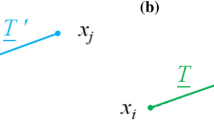Abstract
Investigations on the residual Mode-I fracture behaviors of concrete subjected to elevated temperatures were carried out. Test specimens with the same dimensions, 230 × 200 × 200 mm, were exposed to temperatures varying from 65 to 600°C. The wedge splitting method was employed to obtain the complete load-crack mouth opening displacement curves (P–CMOD) of the post-fire specimens, from which the initial fracture toughness K ini, the critical fracture toughness K ic and the fracture energy G F were calculated. The results demonstrated that K ini decreased monotonically with increasing heating temperature T m; K ic and G F sustained a hold-increase–decrease tendency with T m. Furthermore, the characteristic length l ch, a brittleness parameter, was calculated and it shared the same tendency as K ic–T m and G F–T m. Thus, any of the three parameters could serve as the index of brittleness for post-fire concrete. The fracture parameters and other material properties of concrete could be closely related to the ultimate weight loss.
















Similar content being viewed by others
Abbreviations
- a 0 :
-
Initial notch depth of the specimen and a 0 = 80 mm
- a c :
-
Critical notch depth of the specimen
- B :
-
Thickness of WS specimen and B = 200 mm
- CMOD:
-
Crack mouth opening displacement
- CMODc :
-
Critical crack mouth opening displacement
- E pr :
-
Young’s modulus of prism (kN/mm2)
- f pr :
-
Compressive strength of prism (N/mm2)
- G F :
-
Fracture energy (N/m)
- H :
-
Height of WS specimens and H = 200 mm
- h:
-
Ligament height and h = H − a 0 = 120 mm
- K ini :
-
The initial fracture toughness (MPa m1/2)
- K ic :
-
The critical fracture toughness (MPa m1/2)
- Δ:
-
The value of CMOD (mm)
- Δu :
-
The ultimate value of CMOD
- Δ0 :
-
The ultimate displacement when the specimen is broken
- F(Δ):
-
Corresponding horizontal load to Δ
- P u :
-
Ultimate vertical load
- r :
-
Regression coefficient
- T :
-
Heating temperature
- T m :
-
Maximum heating temperature
- w u1 :
-
Weight loss of specimens after heating to 200°C
- w u :
-
Ultimate weight loss (%)
- w u2 :
-
Weight loss of specimens after heating to 450°C
- l ch :
-
The characteristic length (m)
References
Bazant ZP, Prat PC (1988) Effect of temperatures and humidity on fracture energy of concrete. ACI Mater J 85(4):262–271
Baker G (1996) The effect of exposure to elevated temperatures on the fracture energy of plain concrete. RILEM Mater Struct 29(190):383–388
Zhang B, Bicanic N, Pearce CJ, Balabanic G (2000) Residual fracture properties of normal and high-strength concrete subject to elevated temperatures. Mag Concr Res 52(2):123–136
Nielsen CV, Bicanic N (2003) Residual fracture energy of high-performance and normal concrete subject to high temperatures. RILEM Mater Struct 36(262):515–521
Zhang B, Bicanic N (2006) Fracture energy of high-performance concrete at high temperatures up to 450°C: the effects of heating temperatures and testing conditions (hot and cold). Mag Concr Res 58(5):277–288
Prokopski G (1995) Fracture toughness of concretes at high temperature. J Mater Sci 30:1609–1612
Abdel-Fattah H, Hamoush SA (1997) Variation of the fracture toughness of concrete with temperature. Constr Build Mater 11(2):105–108
Peng G-F, Yang W-W, Zhao J, Liu Y-F, Bian S-H, Zhao L-H (2006) Explosive spalling and residual mechanical properties of fiber-toughened high-performance concrete subjected to high temperatures. Cem Concr Res 36:723–727
Xu SL, Reinhardt HW (1999) Determination of double-K criterion for crack propagation in quasi-brittle fracture, part III: compact tension specimens and wedge splitting specimens. Int J Fract 98:179–193
Hillerborg A, Modeer M, Peterson PE (1976) Analysis of crack formation and crack growth in concrete by means of fracture mechanics and finite elements. Cem Concr Res 6(6):773–782
Jiangtao Y (2007) Experimental and theoretical research on damage assessment of reinforced concrete member after fire. Dissertation, Tongji University, Shanghai
Acknowledgments
The State Laboratory of Disaster Reduction in Civil Engineering (SLDRCE09-D-02) and Young Scientist Project of Natural Science Foundation of China (NSFC) have supported this research.
Author information
Authors and Affiliations
Corresponding author
Rights and permissions
About this article
Cite this article
Yu, J., Yu, K. & Lu, Z. Residual fracture properties of concrete subjected to elevated temperatures. Mater Struct 45, 1155–1165 (2012). https://doi.org/10.1617/s11527-012-9823-4
Received:
Accepted:
Published:
Issue Date:
DOI: https://doi.org/10.1617/s11527-012-9823-4




